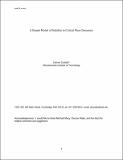A Simple Model of Stability in Critical Mass Dynamics
Author(s)
Centola, Damon
Download10955_2012_679_ReferencePDF.pdf (457.8Kb)
OPEN_ACCESS_POLICY
Open Access Policy
Creative Commons Attribution-Noncommercial-Share Alike
Terms of use
Metadata
Show full item recordAbstract
Collective behaviors often spread via the self-reinforcing dynamics of critical mass. In collective behaviors with strongly self-reinforcing dynamics, incentives to participate increase with the number of participants, such that incentives are highest when the full population has adopted the behavior. By contrast, when collective behaviors have weakly self-reinforcing dynamics, incentives to participate “peak out” early, leaving a residual fraction of non-participants. In systems of collective action, this residual fraction constitutes free riders, who enjoy the collective good without contributing anything themselves. This “free rider problem” has given rise to a research tradition in collective action that shows how free riding can be eliminated by increasing the incentives for participation, and thereby making cooperation strongly self-reinforcing. However, we show that when the incentives to participate have weakly self-reinforcing dynamics, which allow free riders, collective behaviors will have significantly greater long term stability than when the incentives have strongly self-reinforcing dynamics leading to full participation.
Date issued
2013-01Department
Sloan School of ManagementJournal
Journal of Statistical Physics
Publisher
Springer US
Citation
Centola, Damon. “A Simple Model of Stability in Critical Mass Dynamics.” J Stat Phys 151, no. 1–2 (January 5, 2013): 238–253.
Version: Author's final manuscript
ISSN
0022-4715
1572-9613